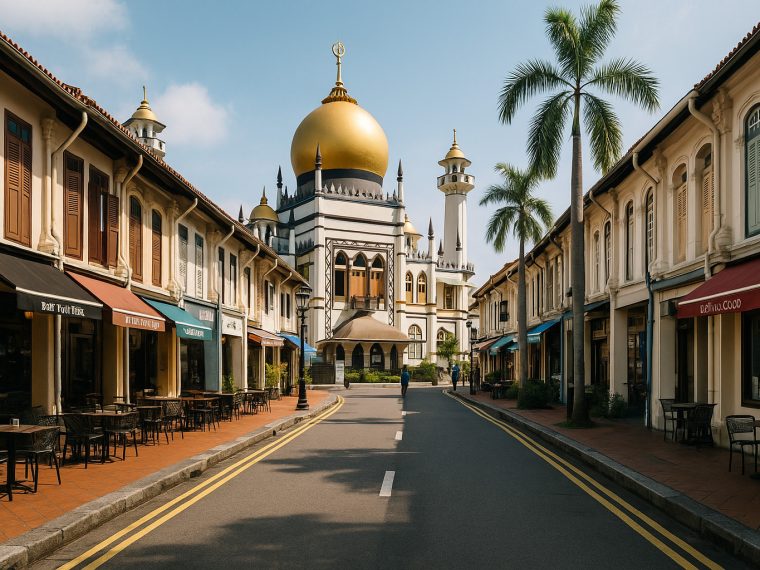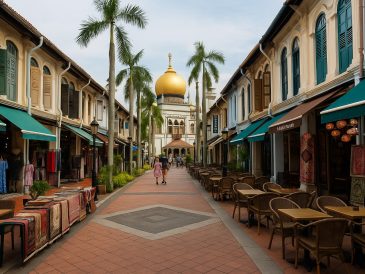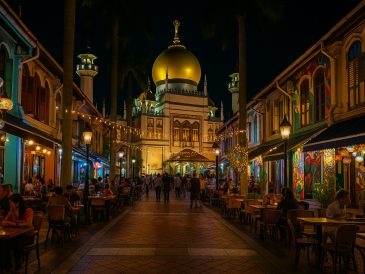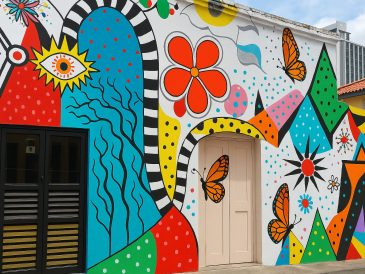Kandahar Street doesn’t try to impress—it simply does. Situated in the heart of Kampong Glam, this street pulls together a tight narrative of Islamic heritage, architectural memory, and multicultural grit. The area was officially gazetted for conservation on July 7, 1989, but its historical weight had long been in place.
A Street Rooted in Royal Beginnings
The history of Kandahar Street begins with a royal deal. In 1824, land in Kampong Glam was allocated to Sultan Hussein Mohamed Shah and his family after the treaty that handed Singapore to the East India Company. This carved out the area as a seat of the Malay and Muslim community.
In 1910, Kandahar Street received its name—alongside streets like Muscat and Bussorah—linking it symbolically to the Muslim world. The area drew Arabs, Javanese, Bugis, and Boyanese migrants who built tight-knit enclaves, sometimes known as “mini-kampongs.” These communities infused the district with cultural threads that remain visible today.
The name “Kampong Glam” comes from the Gelam tree, a species the Orang Laut used for boat-building and medicine. That one tree gave a name to the entire neighborhood, now layered with stories from centuries past.
Landmarks That Speak Without Words
Every major landmark around Kandahar Street carries historical and cultural depth. These aren’t just architectural ornaments—they’re anchors of identity.
- Malay Heritage Centre: Built on the grounds of Istana Kampong Glam, once the palace of Sultan Hussein, this building functions as a cultural archive. Its garden entrance sits quietly on Kandahar Street.
- Istana Kampong Glam: Erected in 1840 by Sultan Ali, this is one of the oldest structures in the area. Though the palace no longer houses royalty, its presence still commands respect.
- Sultan Mosque: Though technically on Bussorah Mall, the mosque’s golden dome and rich history are part of the Kandahar Street experience. It’s one of Singapore’s most photographed religious buildings.
- Shophouses: Running along the street, these two-story units are a consistent reminder of colonial and local architectural fusion. Many have retained their facades while adapting their interiors for restaurants, studios, and retail.
- Pondok Java: What is now a car park used to be a cultural hub for the Javanese community. It was known for theatre performances and arts gatherings. That space, invisible now to the casual eye, once buzzed with storytelling.
Food That Hits Without Hesitation
Kandahar Street doesn’t pander to trends—it stays rooted in bold flavors. The diversity of cuisine along the street mirrors the migration patterns of those who lived here.
Local and Regional Favorites:
- Tash Tish Tosh: Specializes in Malay-American fusion with a standout Tulang Merah dish. A literal red bone stew, it’s not for the mild palate.
- Rumah Makan Minang: Known for Minangkabau-style Indonesian cuisine. Rendang here doesn’t come with apologies—it hits with the kind of depth that only years of tradition can bring.
- Bumbu Restaurant: Combines Thai and Indonesian dishes in an antique-filled setting. The furniture is almost as memorable as the food.
- Zarabi: Brings Moroccan flavor into the neighborhood, offering options that stray from Southeast Asian norms but sit comfortably on the street.
- Peppercorn: Serves up Sichuan cuisine for those who want something less local but still fiery.
Other Mentioned Eateries:
- Cicheti and Maison Ikkoku add to the range with more modern or fusion offerings.
- Taliwang Restaurant used to offer a blend of Italian and Indonesian dishes before closing, adding a short but flavorful chapter to the street’s culinary diary.
Retail and Memory in Motion
While Arab Street takes the crown for textiles and rugs, Kandahar Street holds its own with smaller retail establishments. A few spots are worth noting:
- Rich & Good Cake Shop: Located at 24 Kandahar Street, this bakery is known for its Swiss rolls and long lines. Locals swear by it, and tourists who stumble upon it rarely regret the find.
- Former Blacksmith Shops: The area near Sultan Gate once had blacksmith shops that clanged late into the night. While most are gone, their echo lingers in stories.
- Bazaars: Especially during Ramadan, the street becomes a passageway of food stalls and pop-up retailers. Lights, crowds, and prayer calls mesh into an evening rhythm that’s hard to forget.
The Atmosphere—Built, Not Manufactured
Kandahar Street doesn’t try to repackage its heritage for modern appeal. It exists as it always has—alive with activity, yet grounded in history. The crowd is a mix: elderly residents, young creatives, tourists with cameras, and families headed to prayer. No one seems out of place.
Street art, call to prayer, sizzling pans, and soft evening lights blur into a rhythm. It’s a place where walking slow feels right. The past and present aren’t in tension—they’re in constant negotiation.
Why Kandahar Street Still Matters
Kandahar Street serves as more than a street with good food and historical buildings. It’s a live archive. Every tile, spice, tree, and conversation adds weight to its story. It’s not trying to be trendy. It’s staying present without shedding its past. And that’s why it keeps pulling people in.




